Spaghetti Squash! One vegetable I’ve always been wanting to try but never have. And all I can say is that I’ve been missing out for the past 30 years! It’s fun to prepare, easy to cook, very healthy, and tastes great in many dishes! And for those of you looking for a non-carb or gluten-free pasta alternative, it’s perfect!
You may be asking why I’ve waited so long to give it a try…mainly because I never saw it around much and had only tried it once at a restaurant a few months back. I also thought that you needed to have a special peeler to create the spaghetti-like squash strands, which seemed labor intensive. You can imagine how surprised I was when I walked into Trader Joe’s and they were sampling some cooked spaghetti squash. They were serving it with some meat-based marinara and Parmesan cheese. Excited to try it out, I asked to have a sample with just Parmesan Cheese. The lady preparing the samples said all she did was cook it in the microwave for a few minutes, cut it in half, removed the seeds, and scooped out the spaghetti squash with a spoon! The selling point was that she was doing it right in front of me! That day I found myself walking out of Trader Joe’s with a spaghetti squash in hand. If the cooked spaghetti squash tasted great with just some Parmesan Cheese, I could only imagine what other dishes I could make with it at home!
This recipe was adapted from Skinny Taste. When I saw the recipe, mac n cheese came to mind since I’ve made similar recipes before. Since my husband loves mac n cheese, this was a perfect dish to make, substituting the pasta for the spaghetti squash of course. I made a few changes to the original recipe. I added minced garlic, used sharp cheddar cheese, reduced the overall amount of cheese used, eliminated the vegetable broth, and increased the amount of milk. I found that by doing this, the right consistency and thickness of the sauce prior to baking is easier to achieve. Since there is a lot of spinach in the dish, a lot of water gets released while baking it in the oven. So I would also recommend creating a thick white sauce and baking it for a longer time so that most of the water boils off. For a gluten-free version, I’ve never been a huge fan of using corn starch instead of white flour to make a bechamel white sauce, so I used rice flour instead and couldn’t even tell the difference.
Even if there is some liquid remaining, the dish tastes amazing! I was skeptical about adding so much spinach, but it tastes great and adds a perfect green element to the dish. The sweetness of the spaghetti squash combined with the cheesy white sauce and leafy spinach created a flawless flavor that was completely finished by the end of the night. My 3 1/2 year old son loved it and my carb-loving husband was hoping I was not planning on having any leftovers, because he was planning on finishing the entire baked dish (which by the way, he did)!
You can bet that I will be cooking spaghetti squash in my house at least twice a month! I used to microwave my spaghetti squash to cook it, but have changed to roasting spaghetti squash in the oven. The flavor and texture from cooking the squash in the oven comes out much better than the microwave version. I’m excited to try making my favorite pasta recipes substituting spaghetti squash for the pasta. In fact, the next day for lunch, I had some leftover cooked spaghetti squash and decided to make some one of my favorites – spaghetti squash cacio e pepe (picture below)! My taste buds were in paradise!
Cheesy Baked Spaghetti Squash with Spinach
INGREDIENTS
- 5 1/2 cups cooked spaghetti squash , from 1 large or 2 small spaghetti squash, recipe below indicates method to cook spaghetti sqash
- 1 tbsp vegan butter , such as earth balance brand
- 1/2 tbsp olive oil
- 3 cloves garlic , minced
- 1/4 cup white onion , minced
- 1/4 cup flour , gluten-free option: rice flour
- 2 1/2 cups non-dairy milk , such as cashew milk
- 6 oz. vegan shredded cheese , ~1.5 cups, cheddar or mozzarella
- 4 cups baby spinach
- 1/4 cup vegan parmesan cheese
- salt
- pepper
INSTRUCTIONS
To Prepare 1 Large Spaghetti Squash:
- Preheat the oven to 400 degrees. Cut the squash in half, remove the seeds (with a spoon or ice cream scooper), and bake on a baking sheet for about 25-45 minutes until tender (you should be able to pierce through the flesh easily). Note that baking times may vary based on the size and thickness of your squash. If you over-bake, the strands of spaghetti squash will become mushy (potato-like) when you scrape them out, so be sure not to over-bake them.
- Using a spoon, start to scoop out and separate the flesh of the spaghetti squash until all that remains is the outer shell. You'll notice that the flesh of the squash comes out in strands similar to spaghetti (hence the name "spaghetti squash").
To Prepare the Baked Spaghetti Squash Dish:
- Preheat the oven to 375 degrees.
- In a large sauce pan, heat the butter and olive oil on medium heat.
- Add the onions and garlic and cook for a few minutes until fragrant.
- Add the flour and whisk to combine. Reduce the heat to medium-low and cook for a few minutes, stirring the flour/butter mixture occasionally.
- Slowly add the milk and whisk continuously on medium heat until the mixture becomes smooth and starts to simmer. Continue to simmer, stirring frequently, until the sauce thickens in consistency. Make sure the sauce is thicker than a standard bechamel sauce. As a guide, the sauce is thick enough right when the sauce just starts to clump (just prior to this moment). In other words, the sauce should not pour out in a uniform stream. (see notes below)
- Remove from heat and stir in the shredded vegan cheese (mozzarella or cheddar). Combine until smooth (i.e. the cheese should melt into the sauce).
- Season with salt and pepper.
- Add 5 1/2 cups cooked spaghetti squash and spinach leaves and combine.
- Transfer everything to a baking dish (such as a 9x13 glass tray) and sprinkle the top with grated vegan parmesan cheese.
- Bake for 40-45 minutes until the dish is bubbly and the top is golden. Note that if you do not bake for long enough, the dish may be slightly runny because the water released from the spinach did not have enough time to boil off.
- Remove from the oven and let it sit for 5-10 minutes to allow the dish to finish cooking. Sprinkle some fresh ground black pepper (optional) and serve immediately. Enjoy!
NOTES
- parmesan - I use Violife or Follow Your Heart brand
- cheddar or mozzarella - use Miyako cheddar block, or Daiya cutting board collection
NUTRITION
Nutritional Information Per Serving (see disclosure below): 274.4 Calories, 15.0g Fat (8.8g Saturated), 328.5mg Sodium, 21.1g Total Carbs, 2.6g Fiber, 9.0g Sugars, 13.4g Protein
Nutritional Information Disclosure: I am not a nutritionist or a dietary specialist. I manually calculate approximate nutritional information (by the request of followers) through a free service provided by this website: http://recipes.sparkpeople.com/recipe-calculator.asp where I enter in ingredients and serving size. I am unable to verify every ingredient, it’s source, and it’s nutritional information in their database, and therefore I DO NOT guarantee 100% accuracy of the nutritional information provided above.
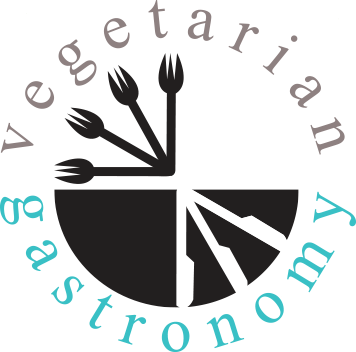

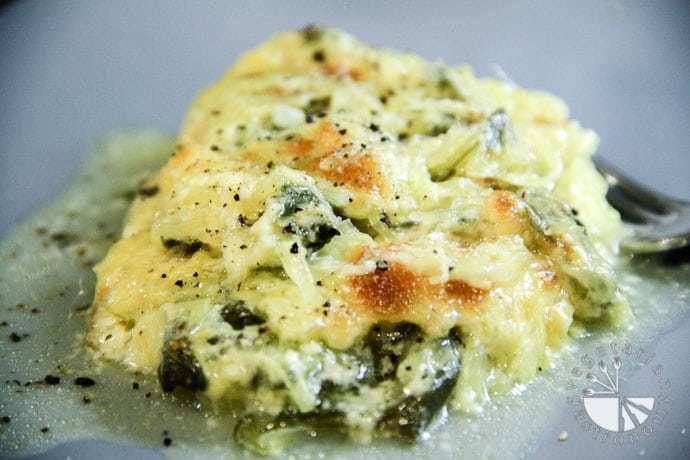
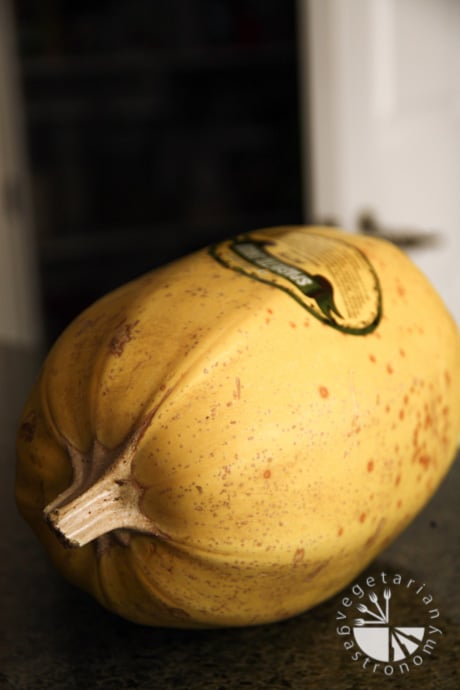
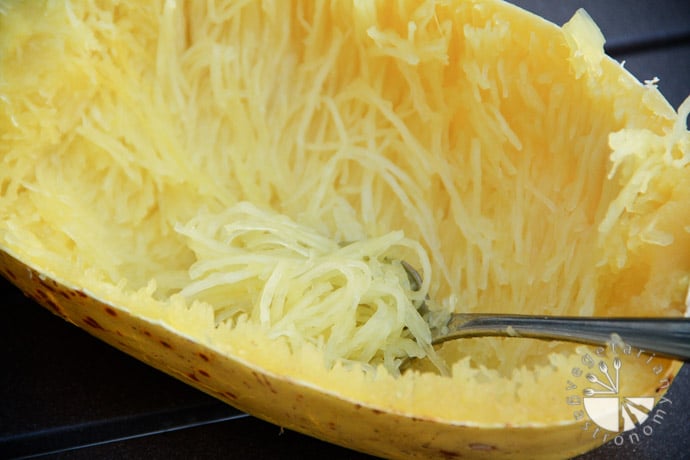
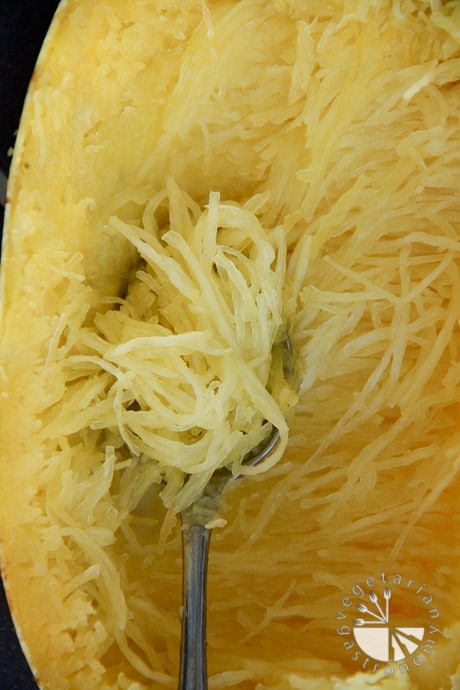
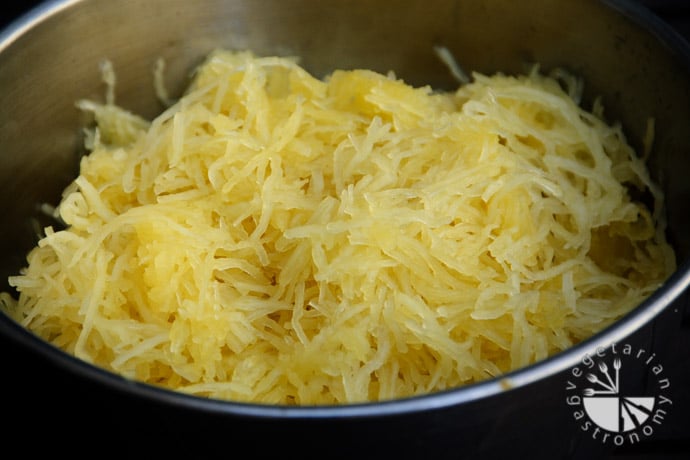
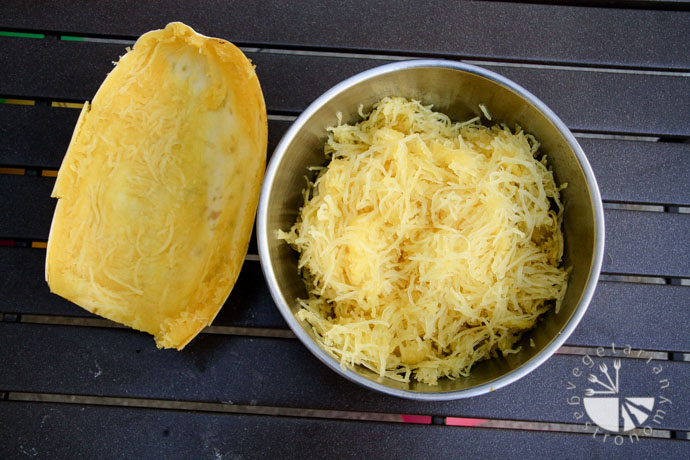
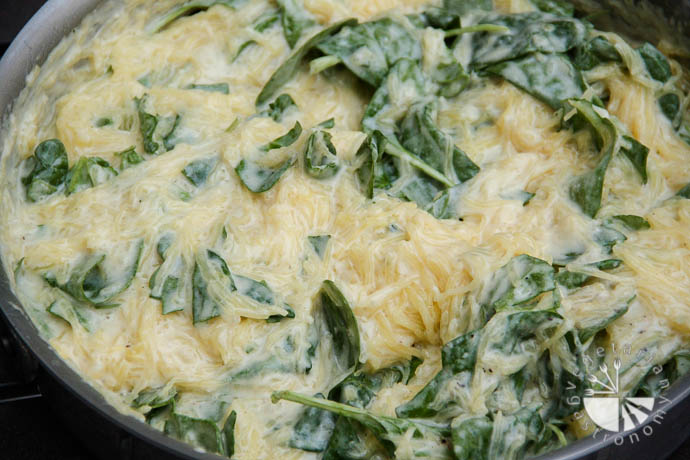
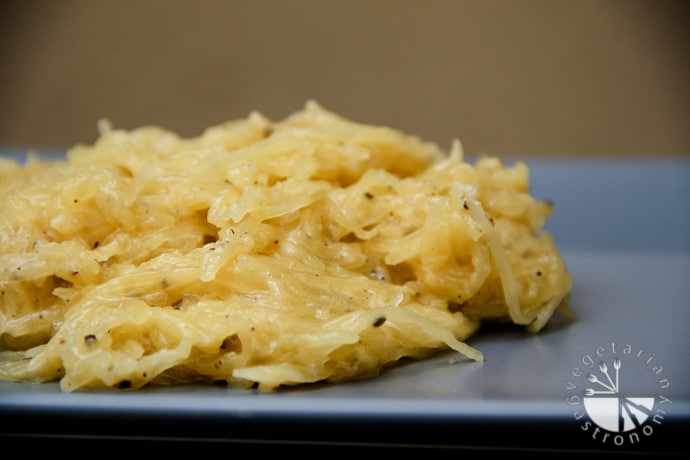
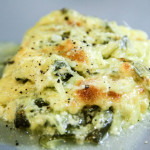
Reema
This squash is sooooo amazing and easy! The white sauce can be tricky but since I did it with someone who knew how it was doable. I doubled the recipe but forgot the cheese, and it was still good with 2 cups but double everything else! Big hit…
anjali
Yeah once you make the white sauce once, it’s super easy to make again! And I love the bechamel sauce because you can use it in so many different dishes to make things creamy and thick without the heavy cream!
Nice to know that you don’t have to add that much cheese to get the same great flavor…I’ll have to try reducing the amount of cheese next time as well to keep it even healthier! So glad you were able to try out spaghetti squash! Let me know if you make any other dishes using it!
Dana
quick question. In the directions it says to add the onion and garlic but I didn’t see an amount of garlic to add in the directions. Is there s specific amount or just to taste? Thanks. I’m making it tonight and I can’t wait.
Dana
I did end up making the dish and everyone loved it. I think I make have overdone the squash a little though because I didn’t get as much spaghetti consistency but after mixing everything together it was still amazing. And I added some grilled chicken that I just baked in the over with some Italian seasoning. The garlic I just used about 2 tb if pre-minced garlic and it came out perfect. Thanks again for the amazing recipe!
anjali
Awesome! Yeah, I’ve over-done the squash many times and it’s become more of a mushy consistency as opposed to the stringy spaghetti consistency, so I’ve just been more careful to stop baking early and check often. Either way, glad you loved the dish! Thanks so much for the comment!
Wren
When I added the flour to the sautéed onions I got clumps of flour covered onions. Then when I added the milk, the flour did not blend with the milk so I put it all in my Vitamix blender and got a smooth creamy sauce.
anjali
Hi! Thanks for the comment! I make this bechamel sauce all the time. When you add the flour, you should get somewhat of a thick semi-clumpy mixture of flour, butter, and onions. But the butter should be well combined with the flour at this point to break it up, especially if you whisk it in. I’ve made this several times and haven’t had a problem with the flour not blending into the milk especially if I add the milk in slowly as I whisk the flour/butter/onion mixture into it.
Once you made a smooth creamy sauce, were you still able to simmer and thicken it? If so how did the rest of the recipe turn out? It would be great to know in case someone encounters this problem. Thanks for visiting my site and hope the recipe still turned out delicious for you!
Jocelyn
I had this problem as well. Maybe I let the butter/oil mix go too long and some of it was cooked off? I added a cup of milk and it combined together well. When I added the cheese, the sauce got really thick, which was worrisome.
Right now my dish is going on 50+ minutes of cooking because it was super liquidy when I took it out after 45. My squash was on the small side, though, so maybe that’s why? Smells delicious though 🙂
anjali
The onions should be added immediately after the butter/oil melt and heat, so I have a feeling unless you left it on for a long time, that the butter/oil mix was not the problem. Once you added the milk, did you let the mixture get nice and thick prior to adding the cheese? Basically because of the liquid that gets released from all the spinach, the sauce itself should be as thick as possible without having clumps in it.
If your sauce was very thick, I’m surprised it was so liquidy even after being in the oven for that long. You mentioned that your squash was on the small side…did you use the correct amount of 5 1/2 cups cooked spaghetti squash? If not, this may be an issue. The thick sauce/spaghetti squash/spinach mixture before you bake it should be quite thick (i.e. it should not be pour-able).
My suggestion at this point (if you haven’t already done so) is to keep cooking until it’s not so liquidy – hopefully this does not take much longer. Remember some of it will thicken once it’s removed from the oven and cooled slightly. Glad that it smells delicious =) Let me know how it turned out!
Jocelyn
Thanks for the quick reply 🙂 I used a wide, shallow pan (soup pan was dirty!) – perhaps the surface area made it evaporate quicker thus more difficult to mix in flour?
The mixture was pretty thick before the cheese, then VERY thick after the cheese. With all the ingredients, it was not pourable. It was also rather thin in a 9×13 pan once cooked, not even half an inch thick, so you’re probably right that I didn’t have enough squash. Ended up cooking for just under an hour and it solidified pretty well. Very tasty indeed! Now to try that cacio e pepe recipe 🙂
anjali
Ah ok…yes that may have been the problem then, especially if it was less than 1/2 in thick after you poured it in the pan…not enough Spaghetti squash. I actually typically make this in my wide shallow pan as well because I find it easier to thicken up the sauce quickly. But regardless, glad it ended up tasting great, even though it took a long time to bake off the liquid!
And YES…the cacio e pepe with spaghetti squash is my absolute favorite quick dish to make. I’ve made cacio e pepe with regular pasta many times as well and it’s one of my favorites. You can either follow the recipe, or simply wing it like I do now! Simply melt some butter or heat some olive oil, add the spaghetti squash, salt, freshly ground black pepper, and parmesan cheese to taste. You may need to add a tiny amount of water as well to make it a little creamy! Either way, it is so good! Thanks for trying out my recipes!
Donna B.
Add the flour to cold milk and mix with a whisk. This will eliminate the chance of clumps. I use this method and it never fails!
anjali
Thanks! The milk is usually added after so the flour can be cooked in the butter. But I’ll have to try your method sometime! =) Does it change the flavor or consistency at all? Thanks for the suggestion and for visiting the site!
Avani
Made this today so I would have dinner to come home to for at least a few days this week. I tasted a bit of it and it was delicious and not to mention very easy to make.
anjali
Excited you tried this dish out Avani! It’s one of my favorites using spaghetti squash and I love how much spinach goes into the dish! Glad you liked it! Smart of you to have made it in advance so you have dinner ready!
Irene Coates
That would be nice to scoop into a single pie crust – me thinks?
anjali
I never even thought of doing that with this recipe, but let me know how it turns out once you give it a try. A lot of water gets released during the baking from the spinach so not sure how the pie crust would hold up. I’m curious to see someone try it =)
Megan F
I tried this recipe tonight it was pretty good I added tomatoes and I think next time I will add a few cloves of garlic(minced) with the onions. Garlic and creamy dishes just go together so deliciously!
anjali
Hi Megan! Agreed…love garlic in most dishes, especially creamy ones! I think I may have to add that as well next time around. =) And thanks for visiting my site…glad you enjoyed the recipe!
Midwife Krysis
This was SO GOOD! I added sauteed mushrooms and next time will saute a bunch of veggies (zucchini, suash, peppers, kale) to add to it. Good enough for holiday side I think.
anjali
So excited you liked the dish! And sauteed mushrooms sounds like a great addition, I’ll have to try it out next time…thanks! This dish with a bunch of veggies sounds like a great side dish for the holidays. Thanks for visiting my site.
Tammy
I do not use flour in my meals so what would you recommend as a replacement?
anjali
Just to clarify, do you not use any type of flour? In other words, is rice flour ok? If so, then I’ve made the white sauce using rice flour several times and it turns out great! But if you do not use ANY flours at all, then it may be difficult to make the white bechamel sauce…instead you may be able to make another sauce in this dish. Let me know if this is the case so I can think of an alternative sauce.
Tammy
All my meals are grain free
anjali
Ok got it…I have not made a bechamel sauce grain-free yet, but I did a few searches and there are many grain-free recipes. I need to look through it more though and try it out before recommending one to you since I haven’t personally made one myself. Until then however, if you are up for trying it, you can leave out the white sauce. Saute some minced garlic and onions, mix the cooked spaghetti squash with a little of your favorite pasta sauce (red or white), spinach, season with salt/pepper, and throw in some mozarella and parmesan cheese into the mix. Then spread it out in a baking dish, top with more parmesan cheese and bake! Should still turn out delicious! I will put a grain-free bechamel white sauce on my list of recipes to look into and hope to get back to you soon. Let me know what you think!
jen
I used arrowroot powder (paleo friendly) instead of flour and it turned out amazing!
anjali
Awesome, so glad you liked the recipe! Nice to know it works with arrowroot powder as well…I actually had another follower as that question. Thank you!
Jennifer
by chance…do you have nurtrition facts for this…approximately what would the calorie intake be for one serving?
anjali
Unfortunately I do not have nutritional facts for this (slowly going back and adding previous nutritional information). But since you asked for it, I’ll get the nutritional info up by the end of the week =) Hope that helps!
Shari
Did you post nutrition? I don’t see it.
anjali
Done…you will find it under the recipe. Sorry for the delay! Hope it helps.
Lori Jackson
As I read through the comments, apparently many have experienced a watery sauce due to the spinach. I would recommend sauteing the spinach with the onions and some garlic, until it releases it’s water and reduces. Then add your flour, cook a few minutes more, then add the milk and follow the recipe for the white sauce as stated. Freshly grated nutmeg would be a wonderful addition to anything with greens and/or cream sauce. I’m going to try this tomorrow!
anjali
Hi Lori! Yes, great suggestion…sauteing the spinach with the onions will definitly help reduce the amount of water released. I’m curious if it will alter the taste of the spinach or sauce in the dish since it will be cooking for much longer (sauteed until water is released with onions), and cooking with the white sauce until it thickens up, and baked in the oven. You may want to reduce the baking time since everything in the dish will be cooked. Regardless, I’m sure you’ll have a great tasting dish doing it that way as well, just may taste a bit different. Nutmeg sounds like a great addition! I love adding it to white sauces.
Once you try it out this way, definitely let me know what you think! Thank you for visiting my site!
s malito
I would like to make this recipe for thanksgiving but the turkey will be in the oven. Do you have any suggestions for baking in the microwave?
anjali
The white sauce and spaghetti squash are actually all already cooked. So by baking it in the oven, it thickens up the dish, cooks the spinach, and bakes off excess liquid/water released from the spinach.
Although I have never optimized this dish in the microwave, it should work just fine. Here is what you can try:
– quickly cook the spinach outside separately in a pan (saute using a tiny amount of oil or butter) until spinach is completely cooked and most of the water released has evaporated
– Make the white sauce to the casserole as thick as you can (without it getting clumpy)
– Simply add the cooked spinach into the dish with the spaghetti squash (the spaghetti squash can easily be baked in the oven ahead of time or even a day or two before)
– Microwave on high for 6-8 minutes. Not sure on the exact time but basically just until it thickens up a bit and the parmesan on top melts. Let the casserole sit out if possible for 10 minutes after so that it finishes cooking.
Should taste great! Let me know how it turns out! Happy Thanksgiving!
anjali
Oh and I forgot to mention actually…the other thing you can do is simply make this casserole and bake it the day before or the night before. I’ve done that plenty of times and then simply reheated in the microwave prior to serving and it still tastes great. Either way, let me know how it goes!
Aimee
This casserole was incredible! Thank you for such a fantastic recipe. I made it for Thanksgiving and was a little nervous about attempting a new recipe, but it was a snap. The sauce came together just as your notes described, but one does have to be patient. It looked gorgeous coming out of the oven and the smell is to die for! The family all loved it, even those who were skeptical of the spaghetti squash. This one may become a tradition.
anjali
Thank you SO MUCH for the great feedback! I’m thrilled that you and your family loved the recipe and that you found it to be easy to make. Thanks for trying out one of my recipes for your Thanksgiving dinner! It’s a family favorite of ours as well. I’ve definitely won many over on spaghetti squash with this casserole =) Happy Holidays!
Dana
I was just wondering how much garlic to use because it’s in the directions but not in the ingredients section. Is it just based on taste? Thanks
anjali
Ah so sorry I missed this! I fixed the recipe…so sorry about that! It’s 2-3 cloves garlic, or you can simply omit completely (which I’ve done on occasion and still love it). I hope you ended up making this dish tonight. If so, let me know how you liked it! Thanks for catching my mistake! =)
Darnell
I used Kale instead and it was PERFECT 🙂
anjali
Great to hear! I actually happen to have a bunch of kale on hand, so I’ll have to try out that substitution next time! Thanks so much for the comment and glad you enjoyed the dish, it’s one of my favorites!
Abbey Butcher
This dish was delicious. I pinned it ages ago and finally got around to making it. It was super easy to prep and my home smelled amazing while it cooked. It did not disappoint once it was finished either. It was super yummy. Thank you for your gift of cooking and your willingness to share your recipes. I’m always looking for new healthy dishes to serve my family.
anjali
Thanks Abbey! I’m so glad you guys all loved the dish…it’s one of my favorites! I fell in love with spaghetti squash with this dish =) Appreciate your kind words…I am a food blogger because of people like you motivating me everyday to create more! =)
Mary
Bake spaghetti squash cut side up or down?
Gluten free family member. Rice flour would work great in this. Just use equal amounts. It actually gets thicker than flour.
If you don’t want to spend forever stirring, heat the milk in the microwave in I ne minute increments, stirring after each minute until warm. You’ll have to stir a lot less, but be prepared to whisk when you add it. It tightens up quick!
anjali
Hi Mary! Cut side up for baking the spaghetti squash. And yes, rice flour would work just fine as the recipe also indicates. I’ve made it this way for my brother who is GF and it turns out great. If you add warm milk to the mixture, yes it will thicken up quicker. Hope you enjoyed the dish!
Patricia
Can I substitute Almond Flour?
anjali
Although I have never tried it myself, I do NOT think almond flour will work as a thickening agent to make the bechamel sauce in this dish. You can substitute rice flour, or even perhaps corn starch or arrowroot to act as the thickener instead of regular flour. I personally have only tried regular flour, and rice flour and both work great. Hope that helps! What type of alternative are you looking for?
Nanci
I’m far too lazy and inept to make the white sauce, plus skeptical about adding all those calories. So I’m going to make this with thawed (frozen) spinach, with the water squeezed out, add some cheese, and let it go at that. I think it will be just as good, with way less calories and not watery.
anjali
I’m sure it will still taste ok the way you are making it. I’m in love with a white bechamel-type sauce. It’s just a little butter, flour, and milk of choice. The calories probably more-so come from all the cheese in the recipe. I also use frozen spinach for a lot of things, but this recipe in particular I actually highly prefer fresh because i’m not a huge fan of the taste of frozen spinach with this baked dish. But again, totally my preference. I’m also now vegan, so i’ve recreated this using almond milk instead of regular milk and other whole food ingredients instead of the cheese (need to add the vegan version at some point). Happy cooking!
Kourtney
Can this be frozen?
anjali
I’ve never done it myself, but yes. I’ve frozen prepared pasta and lasagna several times and this should be fine as well.
Debra Jewett
I filled the outside squash halves with mixture and baked on oven.it cooked great and the roasting gave it an extra flavor. It also soaked up some of the spinach liquid. It was great served with fresh sourdough ???? and butter!
anjali
Great idea stuffing the squash! Thanks for following and trying out the recipe!
Edie Sohigian
Um… amazing! I used Colby Jack instead of cheddar because that is what I had, but this recipe is a keeper! We all had seconds! Thank you for the post.
anjali
Thank you!! Glad you enjoyed the recipe!
lizanne
I didn’t see what the serving size was (or how many servings this makes)… I really need to know this since I’m limited to 1500 mg of sodium a day & have to make sure I don’t go over 500 mg a meal… Could you please provide this?
anjali
Hi! Sorry I didn’t get back to you sooner…for the nutritional information calculated, the serving size is about 5-6 servings, and this recipe makes an entire 9×13″ glass baking stray. Hope that helps! Sorry I missed stating this in the recipe. And please note that I use a free online nutrition calculator as stated under the info. let me know if you need anymore info! Hope you get a chance to try it out!
Jess
Do you think that it would be possible to assemble this dish and refrigerate overnight and bake in the morning? I’ve made it several times before but trying to cut down on morning cooking for Thanksgiving this year.
anjali
I’m so sorry for the late response! I’m overseas on travel so am catching up. Hope you were able to enjoy this dish on thanksgiving!! Did you end up prepping it early? If so how did it turn out? You may have needed to bake for longer but should’ve been fine hopefully.
Lauren Sullivan
Hi,
Do you bake the squash open side up or down?
Thanks!
anjali
You can do it either way, I typically bake it open side up and check often to see if it’s cooked (to avoid over-cooking it).
Kris Marie
We are baking this dish now, but are frustrated that it took 30 plus minutes to make the sauce! The total time from start to finish should have been listed for this recipe. If it had, I would have started the sauce while the squash was getting soft in the oven. Instead, I cooked the squash for 35 minutes. Then stirred a sauce for 35 minutes, and then it still has to bake for 40-50, per comments! We are now going to be 35 min late with dinner because of not knowing the amount of time the sauce would take.
anjali
I’m so sorry to hear this and sorry your dinner was late. I’ve made the sauce in under 30 minutes, but will check again. It’s an older recipe and i’m in the process of going backt o make sure everything and the fields were entered correct. I’ll also be sure to add the multi-tasking tips in the notes. Hope despite the extra time, you enjoyed it.